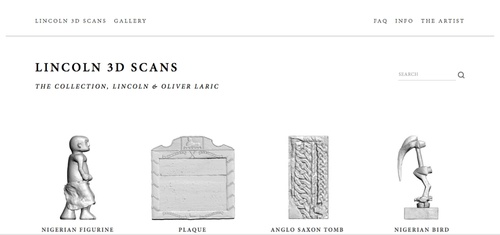Oliver Laric: Lincoln 3D Scans
Oliver Laric: Lincoln 3D Scans
As the tide of a more democratically produced culture laps at the foundation of institutions, questions about what constitutes an “authorized image”—and how this might be shared—have unnerved traditional protocols and troubled longstanding income streams (whereby museums earn revenue from image reproduction). Artist Oliver Laric’s “Lincoln 3D Scans” enters these debates through a loophole that recasts the nature of the image and propels it towards new audiences.
In collaboration with the Collection and Usher Gallery in Lincoln, UK, Laric initiated “Lincoln 3D Scans,” a project comprised of scanning and publishing 3-D models of works in the institutes’ archive. Presented as part of the New Museum’s online exhibition series First Look, this experimental and open-ended project’s original premise is described succinctly on its website: “[Lincoln 3D Scans] aims at making the collection available to an audience outside of its geographic proximity and to treat the objects as starting points for new works.” The Lincoln models—virtualized national treasures that are now free to download—have been picked up by those with animation skills. Resulting new works include Einstein by Matthew Williamson, in which an original nineteenth-century bronze bust has been transformed into an undulating purple GIF with an unearthly patina. Marble Boy, from an artist who identifies himself simply as “Cyril,” is an image of an enlarged sculpture of a kneeling boy dropped into a sepia-toned photograph of an American frontier town—a transformation that lends the sculpture an extraterrestrial appearance, as if it had fallen into the street like space debris. Adding a new layer to the original collection, the “Lincoln 3D Scans” website contains the open source models and tracks new works (such as the ones above) in a dedicated gallery.
This new inquiry extends Laric’s research into the status of a copy versus the original, a strong current running throughout the artist’s work. “Lincoln 3D Scans” redraws the boundaries of the collection and, in so doing, points to a shifting attitude towards art. Where artworks were once appreciated by standing in their presence or gazing at their images, now, viewers need to gain proximity: to touch, alter, or insert themselves into their sanctified space. Culture, regardless of its provenance or age, is surrendering to so many hands that are now making it anew.1
Established in 2012 and co-organized by the New Museum and Rhizome, First Look is a digital art commissioning and exhibition program representing the breadth of art online—from interactive documentary, to custom-built participatory applications, to moving image-based works, and art for mobile VR. Encompassing a substantial array of work that continues to expand, First Look explores the formal, social, and aesthetic possibilities of emerging technologies on the web.
